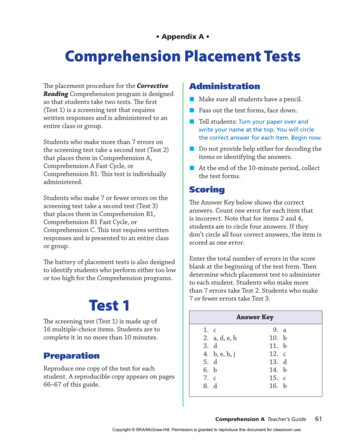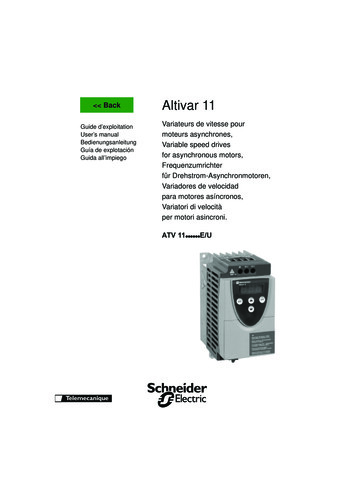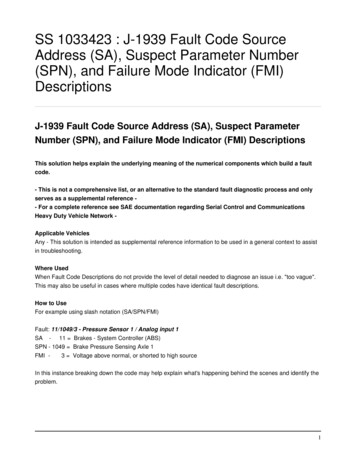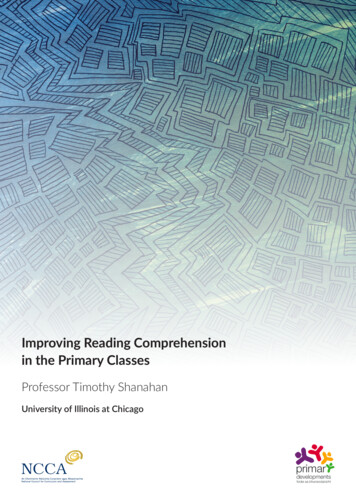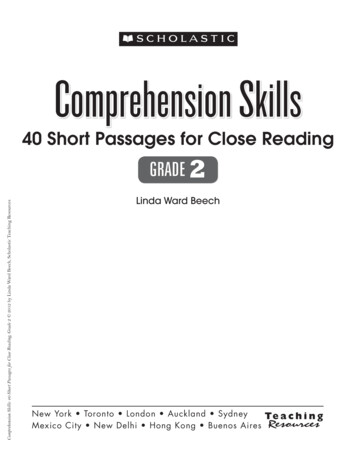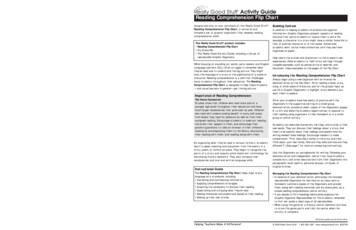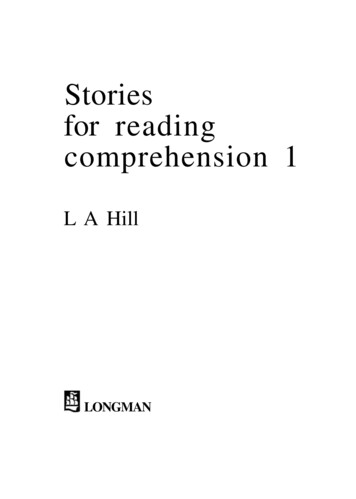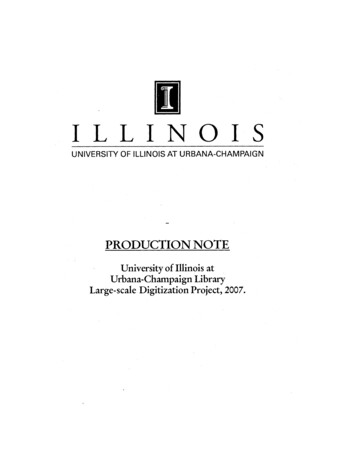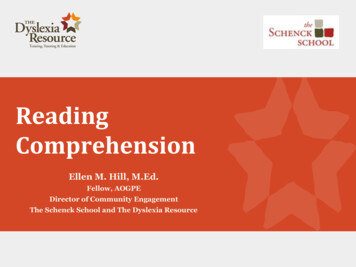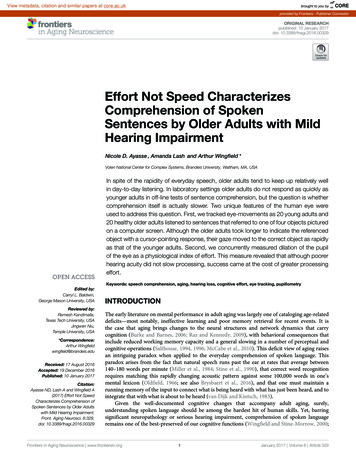
Transcription
View metadata, citation and similar papers at core.ac.ukbrought to you byCOREprovided by Frontiers - Publisher ConnectorORIGINAL RESEARCHpublished: 10 January 2017doi: 10.3389/fnagi.2016.00329Effort Not Speed CharacterizesComprehension of SpokenSentences by Older Adults with MildHearing ImpairmentNicole D. Ayasse , Amanda Lash and Arthur Wingfield *Volen National Center for Complex Systems, Brandeis University, Waltham, MA, USAIn spite of the rapidity of everyday speech, older adults tend to keep up relatively wellin day-to-day listening. In laboratory settings older adults do not respond as quickly asyounger adults in off-line tests of sentence comprehension, but the question is whethercomprehension itself is actually slower. Two unique features of the human eye wereused to address this question. First, we tracked eye-movements as 20 young adults and20 healthy older adults listened to sentences that referred to one of four objects picturedon a computer screen. Although the older adults took longer to indicate the referencedobject with a cursor-pointing response, their gaze moved to the correct object as rapidlyas that of the younger adults. Second, we concurrently measured dilation of the pupilof the eye as a physiological index of effort. This measure revealed that although poorerhearing acuity did not slow processing, success came at the cost of greater processingeffort.Keywords: speech comprehension, aging, hearing loss, cognitive effort, eye tracking, pupillometryEdited by:Carryl L. Baldwin,George Mason University, USAReviewed by:Ramesh Kandimalla,Texas Tech University, USAJingwen Niu,Temple University, USA*Correspondence:Arthur Wingfieldwingfield@brandeis.eduReceived: 17 August 2016Accepted: 19 December 2016Published: 10 January 2017Citation:Ayasse ND, Lash A and Wingfield A(2017) Effort Not SpeedCharacterizes Comprehension ofSpoken Sentences by Older Adultswith Mild Hearing Impairment.Front. Aging Neurosci. 8:329.doi: 10.3389/fnagi.2016.00329INTRODUCTIONThe early literature on mental performance in adult aging was largely one of cataloging age-relateddeficits—most notably, ineffective learning and poor memory retrieval for recent events. It isthe case that aging brings changes to the neural structures and network dynamics that carrycognition (Burke and Barnes, 2006; Raz and Kennedy, 2009), with behavioral consequences thatinclude reduced working memory capacity and a general slowing in a number of perceptual andcognitive operations (Salthouse, 1994, 1996; McCabe et al., 2010). This deficit view of aging raisesan intriguing paradox when applied to the everyday comprehension of spoken language. Thisparadox arises from the fact that natural speech runs past the ear at rates that average between140–180 words per minute (Miller et al., 1984; Stine et al., 1990), that correct word recognitionrequires matching this rapidly changing acoustic pattern against some 100,000 words in one’smental lexicon (Oldfield, 1966; see also Brysbaert et al., 2016), and that one must maintain arunning memory of the input to connect what is being heard with what has just been heard, and tointegrate that with what is about to be heard (van Dijk and Kintsch, 1983).Given the well-documented cognitive changes that accompany adult aging, surely,understanding spoken language should be among the hardest hit of human skills. Yet, barringsignificant neuropathology or serious hearing impairment, comprehension of spoken languageremains one of the best-preserved of our cognitive functions (Wingfield and Stine-Morrow, 2000;Frontiers in Aging Neuroscience www.frontiersin.org1January 2017 Volume 8 Article 329
Ayasse et al.Age, Hearing, and Speech Comprehensioninstructed to look at a target picture (e.g., ‘‘look at the candle’’) tomeasure the speed of isolating a named target from competitorobjects (Ben-David et al., 2011), and tracked eye-gaze whenparticipants have been asked to point to a named object (Hadaret al., 2016) or printed word (Salverda and Tanenhaus, 2010)displayed on a touch screen, or to select a named object byclicking on the correct object picture using a computer mouse(Allopenna et al., 1998). In the present study we used the latteras our overt response measure.Peelle and Wingfield, 2016). Underlying this success, however,one may still ask: (1) whether such comprehension occursas rapidly for older adults relative to younger adults; and(2) whether older adults’ success at speech comprehensionrequires more effort compared to younger adults. These twoquestions have not heretofore been easy to answer.A common approach to addressing the first of these questionshas been to measure the relative speed with which youngerand older adults can indicate the answer to a comprehensionor semantic plausibility question after a sentence has beenheard. These studies have typically employed a verbal or manualresponse, such as a key press, to indicate the moment themeaning of the sentence has been understood. Such measureshave uniformly implied that older adults are slower in processingspeech input than younger adults (e.g., Wingfield et al., 2003; Tunet al., 2010; Yoon et al., 2015). Less clear, however, is the extent towhich such off-line, after-the-fact overt responses serve as a truemeasure of when comprehension has actually occurred (Caplanand Waters, 1999; Steinhauer et al., 2010).Pupil Dilation as a Measure of ProcessingEffortPertaining to our second question, a number of behavioralmethods have been proposed to measure processing effort. Onemay, for example, assess the degree of effort by the degree towhich conducting a speech task interferes with a concurrentnon-speech task (e.g., Naveh-Benjamin et al., 2005; Sarampaliset al., 2009; Tun et al., 2009). Although informative, suchdual-task studies are prone to trade-offs in the momentaryattention given to each task that may complicate interpretation.Ratings of subjective effort have shown mixed reliability, as wellas being an inherently off-line measure (McGarrigle et al., 2014).To avoid these pitfalls we took advantage of an unusualfeature of the pupil of the human eye. Beyond the reflexivechange in pupil diameter in response to changes in ambientlight, and the discovery that the pupil enlarges with a state ofemotional arousal (Kim et al., 2000; Bradley et al., 2008), pupildiameter also increases with control of attention (Unsworthand Robinson, 2016) and increases incrementally with anincrease in the difficulty of a perceptual or cognitive task(Kahneman and Beatty, 1966; Beatty, 1982; see the review inBeatty and Lucero-Wagoner, 2000). Importantly, when usedwhile participants are listening to a sentence, pupillometryhas the critical advantage of allowing an index of processingeffort that does not interfere with performance on the speechtask itself (e.g., Kuchinsky et al., 2013; Zekveld and Kramer,2014).Eye-Gaze as a Measure of ProcessingSpeedTo address this question, we took advantage of the finding thatan individual’s eye-gaze to a picture of an object on a computerscreen can be closely time-locked to its reference in a spokensentence, such that eye-tracking can serve as a useful techniquefor studying real-time (in-the-moment) speech comprehension(Cooper, 1974; Tanenhaus et al., 2000; Huettig et al., 2011; Wendtet al., 2015; Huettig and Janse, 2016).Since our question pertains to age differences, it is alsofortunate that there are only minimal age differences in thevelocity of saccadic eye movements (Pratt et al., 2006). Wethus reasoned that measuring both overt responses and eye-gazeresponses would allow us to determine whether the assumptionthat age-related slowing extends to speech comprehension isnecessarily correct, or whether estimates of age differences inspeed of comprehension have been exaggerated by slowing in theresponse measures themselves.Our research strategy was to present younger and older adultsrecorded sentences that referred to a particular object, with theirtask being to select, as quickly as possible, the correct one of fourpictured objects displayed on a computer screen. Our contrastwould be the potential age difference in the time to indicate thereferenced object with an overt, off-line selection response, vs. themoment the participants’ eyes fixated on the referenced object asan on-line measure of when the referenced object was actuallyunderstood.In the original ‘‘visual world’’ eye-tracking paradigmparticipants viewed objects on a computer screen withinstructions such as ‘‘put the apple that is on the towel inthe box’’. Using an eye-tracking apparatus that recorded wherethe eye was fixated on the computer screen, it was found thatthe participants’ eye gaze moved from object to object as thesentence was being understood as it unfolded in real time(Tanenhaus et al., 1995; see also Cooper, 1974). Subsequentresearch has recorded time-locked eye-gaze for participantsFrontiers in Aging Neuroscience www.frontiersin.orgMATERIALS AND METHODSParticipantsParticipants were 20 younger adults (6 men, 14 women) rangingin age from 18 to 26 years (M 21.2 years) and 20 olderadults (5 men, 15 women) ranging in age from 65 to 88 years(M 73.6 years). The younger adults were university studentsand staff and the older participants were healthy communitydwelling volunteers. All participants were self-reported nativespeakers of American English, with no known history ofstroke, Parkinson’s disease, or other neurologic involvement thatmight compromise their ability to perform the experimentaltask.All participants were screened using the Shipley vocabularytest (Zachary, 1986) to insure that any potential age differencesin the experimental task would not be due to a chance differencein vocabulary knowledge. As is common for healthy older adults(Kempler and Zelinski, 1994; Verhaeghen, 2003), the older adults2January 2017 Volume 8 Article 329
Ayasse et al.Age, Hearing, and Speech Comprehensionasked to indicate if possible which object was being referencedby the sentence. The KP for each sentence was operationallydefined as the earliest word in a sentence at which at least 90%of the participants knew the target word. For the majority ofsentences, the KP was the same for younger and older adults.(Fifty-five sentences were initially constructed. In 10 sentencesthe KP differed by one word between the age groups. Thesesentences were not used in the main experiment, resulting in44 sentences with age-invariant sentence-final word agreementthat would serve as stimuli).in this study had an advantage in terms of vocabulary knowledgerelative to the younger adults (M older 16.6, SD 2.43; Myounger 13.8, SD 1.71; t (38) 4.01, p 0.001).Audiometric evaluation was carried out for all participantsusing a Grason-Stadler AudioStar Pro clinical audiometer(Grason-Stadler, Inc., Madison, WI, USA) by way of standardaudiometric techniques in a sound-attenuated testing room.The younger adults had a mean better-ear pure tone thresholdaverage (PTA) of 7.6 dB HL (SD 4.1) averaged across 500,1000, 2000 and 4000 Hz, and a mean better-ear speech receptionthreshold (SRT) of 11.4 dB HL (SD 3.9). The older adults hada mean better-ear PTA of 24.7 dB HL (SD 8.7), and a meanbetter-ear SRT of 25.9 dB HL (SD 8.0). As is typical for theirage ranges (Morrell et al., 1996), the older adults as a group hadsignificantly elevated thresholds relative to the younger adults(t (38) 6.14, p 0.001). None of the older adults were regularusers of hearing aids.Vision screening was conducted using a Snellen eye chart(Hetherington, 1954) at 20 feet and the Jaeger close visioneye chart (Holladay, 2004) at 12 inches. All participants hadcorrected or uncorrected visual acuity at or better than 20/50 forboth near and far vision.This study was carried out in accordance with the approvalof the Brandeis University Committee for the Protection ofHuman Subjects. All subjects gave written informed consent inaccordance with the Declaration of Helsinki.Visual StimuliFor each trial the participants were presented with an arrayof four pictures of objects displayed in the four corners of a1280 1040-pixel computer screen. Each object was surroundedby a 100-pixel diameter black ring to indicate the area withinwhich the participant would be asked to place the computercursor to indicate his or her selection. A 50-pixel red fixationcircle was centered on the computer screen. Pictures wereselected predominantly from the normed color image set ofRossion and Pourtois (2004), supplemented by images takenfrom clip art databases selected to match the Rossion andPourtois images in terms of visual style.In all cases, one of the pictures corresponded to the finalword of the sentence that would be heard (target picture). Theother three pictures (lure pictures) were always unrelated to thesentence meaning. None of the lure pictures were phonologicalcompetitors for the respective target word, and each set of lurepictures came from distinct functional categories. Figure 1Bshows an illustrative stimulus array for the example sentenceshown in Figure 1A.StimuliSpeech MaterialsThe stimuli consisted of 44 sentences recorded by a femalespeaker of American English. The sentences were spoken withnatural prosody and speech rate. The spoken sentences wererecorded on computer sound files using Sound Studio v2.2.4(Macromedia, Inc., San Francisco, CA, USA) that digitized(16-bit) at a sampling rate of 44.1 kHz. Root-mean-square (RMS)amplitude was equated across sentences. Each of the sentencesmade reference to a picturable object that always formed the lastword of the sentence. The waveform of an example sentence isshown in Figure 1A.Because listeners may continually update their understandingof a sentence as it is being heard, it is possible for the referentof a sentence to be understood before the sentence has beenfully completed (Huettig, 2015; Padó et al., 2009). To take thisinto account, we determined the knowledge point (KP) for eachsentence; the point at which a cloze procedure conducted in acontrol study showed that both younger and older adults wouldknow the likely identity of the sentence-final word. As illustratedin Figure 1A, for this example the KP occurred at the worddoor.The KP was determined for each sentence using a clozeprocedure with a separate group of participants (27 youngeradults, 9 males and 18 females; M age 20.2, SD 1.20, and26 older adults, 7 males and 19 females; M age 72.3 years,SD 5.56). Each sentence was presented visually, one wordat a time, as participants viewed four object pictures, one ofwhich would be the last word of the sentence being presented.As each word of the sentence was presented participants wereFrontiers in Aging Neuroscience www.frontiersin.orgProcedureParticipants were seated 60 cm from the computer screen withtheir head placed in a custom-built chin rest to stabilize headmovement. Each trial began with the participant positioning thecomputer cursor on the red fixation circle. This was followedby a 2 s display of the particular four-picture array for thattrial to allow the participant to familiarize himself or herselfwith the pictures and their positions on the computer screen.After the 2 s familiarization period the fixation circle turnedblue. This signaled the participant to click on the fixationcircle to initiate the sentence presentation. The participant’sinstructions were to listen carefully to the sentence and tochoose the picture that they believed corresponded to thelast word of the sentence as soon as they believed theyknew the word. They were to indicate this by using thecomputer mouse to move the cursor from the fixation circleto the target object and clicking on the mouse to confirm theselection. The computer recorded the moment in time that theparticipant ‘‘clicked’’ on the correct picture with the mouse (overtresponse time, ORT). Instructions were to respond as rapidly aspossible.Throughout the course of each trial the participant’s momentto-moment eye-gaze position on the computer screen andchanges in pupil size were recorded via an EyeTrac 6000(Model 6 series, Applied Science Laboratories, Bedford, MA,3January 2017 Volume 8 Article 329
Ayasse et al.Age, Hearing, and Speech ComprehensionFIGURE 1 Experimental stimuli and procedures. (A) Waveform of an example sentence showing the knowledge point (KP) based on a cloze procedure, therelative times after the KP that participants’ eye-fixation indicated knowledge of the target object (eye fixation time; EFT), and when the target picture was selectedwith the computer mouse (overt response time; ORT). (B) An example picture array. Depicted in the bottom left corner is the target picture (key), while the other threepictures represent unrelated lures.as the point at which this difference in proportions of fixationsexceeded a 15% threshold for 200 ms or more (Wendt et al., 2014,2015).The EFTs and the ORTs were measured from the wordrepresenting the KP for that sentence. This measure was takenfrom the midpoint of the KP word to take into account thefinding that word recognition often occurs before the fullduration of a word has been heard, especially when heard withina sentence context (Grosjean, 1980; Wayland et al., 1989; Lashet al., 2013). Data for incorrect initial target selections wereexcluded from the analyses (M 6.8% of trials for older adults;M 4.8% of trials for younger adults).The waveform of the example sentence in Figure 1A shows,along with the KP, the mean EFT on the correct picture, andthe mean ORT represented by the mouse-click on the correctobject picture. This example is typical in that, for the averageparticipant, the eye fixated on the target picture before the fullsentence had been completed, while the overt response occurredshortly after the sentence had ended.Figure 2 quantifies these data for the younger and olderparticipants. The results show both an expected finding and aless expected finding based on claims of generalized slowing inadult aging (Cerella, 1994; Salthouse, 1996). The vertical barson the right side of Figure 2 show the mean latency fromthe KP in a sentence to the overt response for the youngerand older adults. These are exactly the results that would beexpected based on generalized slowing in older adults, withthe older adults showing significantly longer response latenciesthan the younger adults (t (38) 4.65, p 0.001). The twovertical bars on the left side of Figure 2 show, for the sameparticipants, the mean latencies from the KP to the time pointUSA) eye-tracker that was situated below the computer screenand calibrated using EyeTrac software. These data as well ascomputer mouse movements and response-selection mouseclicks were recorded via Gaze Tracker software (Eye ResponseTechnologies, Inc., Charlottesville, VA, USA) at a rate of60 Hz. The sentences and pictures were presented via a customMATLAB (MathWorks, Natick, MA, USA) program.The sentences were presented binaurally over Eartone 3A(E-A-R Auditory Systems, Aero Company, Indianapolis, IN,USA) insert earphones. To insure audibility sentences werepresented at 25 dB above each individual’s better-ear SRT. Themain experiment was preceded by three practice trials usingthe same procedures as used in the experiment. None of thesesentences or pictures was used in the main experiment.RESULTSEye Fixations and Overt Response TimesWith our procedures we thus had two measures for eachsentence presentation: the ORT, indicating the participant’sunderstanding of the sentence by the speed with which theyplaced the computer cursor and ‘‘clicked’’ on the referencedobject on the computer screen, and the eye fixation time (EFT):the time point at which the participant’s eye first fixed longer onthe correct target picture than on the lures. This latter measurewas based on prior studies using eye-tracking (Huettig et al.,2006; Wendt et al., 2014). For each trial, the proportion of timespent fixating on each of the three lures (averaged over thethree lures) was subtracted from the proportion of time spentfixating on the target picture in 200 ms time bins (Huettiget al., 2006; Wendt et al., 2014). The EFT was operationalizedFrontiers in Aging Neuroscience www.frontiersin.org4January 2017 Volume 8 Article 329
Ayasse et al.Age, Hearing, and Speech ComprehensionPupillometry Measures and Hearing AcuityTo explore the possibility that hearing acuity differences amongthe older adults may have affected processing effort, we separatedthe older adult participants into two subgroups based on amedian split of hearing acuity.The normal hearing older adult group consisted of the 10older adults with better hearing acuity, having PTAs rangingfrom 10 dB HL to 24 dB HL. We use the term ‘‘normal’’ althoughthis group includes individuals with a slight hearing loss (definedas PTAs between 15–25 dB HL; Newby and Popelka, 1992).Although representing thresholds elevated relative to normalhearing young adults, this range is typically defined in theaudiological literature as clinically normal hearing for speech(Katz, 2002).The hearing-impaired older adult group consisted of the 10older adults with relatively poorer hearing acuity, having PTAsranging from 26 dB HL to 40 dB HL. These participants’ PTAslie within the range typically defined as representing a mildhearing loss (26–40 dB HL; see Newby and Popelka, 1992; Katz,2002).The left, middle, and right panels of Figure 3 show better-earaudiometric profiles from 500 Hz to 4000 Hz for the youngadults, the 10 normal-hearing older adults and the 10 hearingimpaired older adults, respectively. These data are plotted in theform of audiograms, with the x-axis showing the test frequenciesand the y-axis showing the minimum sound level (dB HL) neededfor their detection. Hearing profiles for individual listenerswithin each participant group are shown in color, with the groupaverage drawn in black. The shaded area in each of the panelsindicates thresholds less than 25 dB HL, a region, as indicatedabove, commonly considered as clinically normal hearing forspeech (Katz, 2002).The normal-hearing and hearing-impaired older adults weresimilar in age, with the normal-hearing older adults rangingin age from 65 to 88 years (M 73.1 years, SD 7.17) andthe hearing-impaired older adults ranged in age from 68 to81 (M 74.2, SD 4.22; t (18) 0.40, p 0.70). The twogroups were also similar in vocabulary knowledge as measuredby the Shipley vocabulary test (Zachary, 1986; Normal-hearingM 16.3, SD 2.21; Hearing-impaired M 16.6, SD 2.76;t (18) 0.27, p 0.53).Pupil size was continuously recorded at a rate of 60 timesper second using the previously cited ASL eye tracker (Model6 series, Applied Science Laboratories, Bedford, MA, USA).routed through the presentation software (GazeTracker, AppliedScience Laboratories, Bedford, MA, USA) to allow for pupil sizemeasurements to be synchronized in time with the speech input.Measures of pupil diameter were processed with software writtenwith Matlab 7 (Mathworks, Natick, MA, USA).Eye blinks were determined by a sudden drop in verticalpupil diameter and were removed from the recorded dataprior to data analysis. As is common in pupillometry studies,blinks were defined by a change in the ratio between thevertical and the horizontal pupil diameter. For an essentiallycircular pupil, the ratio would be approximately 1.0. Duringa blink or semi-blink the ratio quickly drops toward 0. Allsamples with a ratio differing more than 1 SD from the meanFIGURE 2 Results for gaze time and overt responses. Two vertical barson the left show mean latencies from the KP in a sentence to the time pointwhen younger and older adults’ eyes fixated longer on the target picture thanon the lures (EFT). Two vertical bars on the right show the mean latency fromthe KP in a sentence to the selection of the correct target picture with acomputer mouse (ORT). Error bars are one standard error. Significantpairwise differences, p 0.001.where listeners’ eye gaze fixated more on the target picture thanon the non-target lures. It can be seen that, by this measure, theolder adults were no slower in knowing which object was beingindicated by the sentence than the younger adults (t (38) 1.01,p 0.32).This dissociation between knowing the identity of thereferenced object, as evidenced by the participant’s eyemovements to the target picture, and indicating this knowledgeby an overt response, was supported by a 2 (Responsetype: EFT, ORT) 2 (Age: Younger, Older) mixed-designanalysis of variance (ANOVA), with response type as awithin-participants factor and age as a between-participantsfactor. This confirmed a significant main effect of responsetype (F (1,38) 447.19, p 0.001, ηp2 0.922), and ofage (F (1,38) 18.69, p 0.001, ηp2 0.330), with thedissociation of age effects on the two measures revealed in asignificant Response type Age interaction (F (1,38) 20.51,p 0.001, ηp2 0.351). That is, while older adults mayappear slower in comprehending a spoken sentence using ameasure that includes decision-making and an overt response(off-line measures that typify reports of age-related slowingin speech comprehension), the eye movement data reveal thatthe older adults’ time to actually comprehend the semanticdirection of a sentence was not significantly slower than youngeradults’.As previously noted, stimuli were presented at a loudnesslevel relative to each individual’s SRT (25 dB above SRT). Thisprocedure was followed to ensure that the stimuli would beaudible for all participants. Following the above-cited ANOVA,we conducted an analysis of covariance (ANCOVA) withbetter-ear PTA as a covariate. This analysis confirmed thesame pattern of main effects and the Response type Ageinteraction with these effects uninfluenced by hearing acuity.Although confirming that our presentation of the speech stimuliat an equivalent suprathreshold level for each participant wassuccessful in ensuring audibility of the stimuli, this should notnecessarily imply that those with better and poorer hearing acuityaccomplished their success with equivalent listening effort.Frontiers in Aging Neuroscience www.frontiersin.org5January 2017 Volume 8 Article 329
Ayasse et al.Age, Hearing, and Speech ComprehensionFIGURE 3 Better-ear pure-tone thresholds from 500 Hz to 4000 Hz for the three participant group. Hearing profiles for individual listeners within eachparticipant group are shown in color, with the group average drawn in black. The shaded area in each of the panels indicates thresholds less than 25 dB HL (therange considered clinically normal for speech; Katz, 2002).the point of participants’ eye fixation on the correct object picturerelative to the lure pictures. This time window was intended tocapture the processing effort leading up to this moment (Bitsioset al., 1996).A one-way ANOVA conducted on the data shown in Figure 4yielded a significant effect of participant group on pupil diameter(F (2,37) 8.22, p 0.001, ηp2 0.308), with Bonferonni posthoc tests confirming that the hearing-impaired older adultsshowed a significantly greater increase in relative pupil sizeleading up to their eye fixation on the correct object pictureas compared to either the younger adults (p 0.003) or thenormal-hearing older adults (p 0.003). The difference inrelative pupil sizes between the young adults and the normalhearing older adults was not significant (p 1.00). This generalpattern was seen for pupil sizes at the time of the overt response,were eliminated (Piquado et al., 2010; see also Zekveld et al.,2010; Kuchinsky et al., 2014; Winn et al., 2015; Wendt et al.,2016).When comparing relative changes in pupil sizes acrossage groups it is necessary to adjust for senile miosis, wherethe pupil of the older eye tends to be generally smaller insize, to have a more restricted range of dilation, and to takelonger to reach maximum dilation or constriction (Bitsioset al., 1996). To the extent that a change in pupil sizeis a valid index of processing effort, an absolute measureof a task-evoked pupil size change would thus tend tounderestimate older adults’ effort relative to that of youngeradults.To adjust for this potential age difference in the pupillaryresponse, pupil sizes were normalized by measuring, for eachindividual prior to the experiment, the range of pupil sizechange as the participant viewed a dark screen (0.05 fL) for10 s followed by a white screen (30.0 fL) for 10 s. Based onthe individual participant’s minimum pupil constriction andmaximum pupil dilation, we scaled his or her pupil diameteraccording to the equation: (dM dmin ) / (dmax dmin ) 100,where dM is the participant’s measured pupil size at anygiven time point, dmin is their minimum pupil size (measuredduring presentation of the white screen), and dmax is theirmaximum pupil size (measured during presentation of theblack screen; Allard et al., 2010; Piquado et al., 2010). Pupilsizes were additionally adjusted to account for any trial-to-trialvariability in pupil diameter (Kuchinsky et al., 2013; Wendtet al., 2016), using a baseline of the mean pupil diameterduring a 2-s pre-sentence silence as the dmin in the aboveequation and the maximum post-sentence pupil diameter as thedmax .Figure 4 shows the accordingly adjusted mean pupil sizes forthe three participant groups over a 1-s time window precedingFrontiers in Aging Neuroscience www.frontiersin.orgFIGURE 4 Mean adjusted pupil diameter leading up to the moment ofcomprehension. Pupil diameters calculated over a 1-s window precedingparticipants’ eye fixations on the target picture. Data are shown for youngeradults (left vertical bar), older adults with normal hearing acuity (middle verticalbar), and older adults with hearing impairment (right vertical bar). Error barsare one standard error. Significant pairwise differences, p 0.01.6January 2017 Volume 8 Article 329
Ayasse et al.Age, Hearing, and Speech
Peelle and Wingfield,2016). Underlying this success, however, one may still ask: (1) whether such comprehension occurs as rapidly for older adults relative to younger adults; and (2) whether older adults' success at speech comprehension requires more effort compared to younger adults. These two questions have not heretofore been easy to answer.

